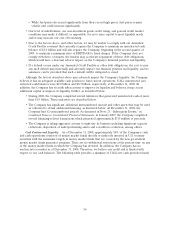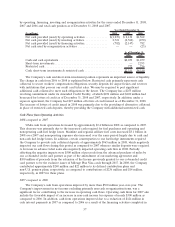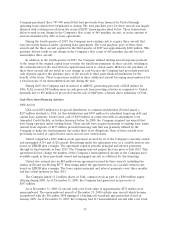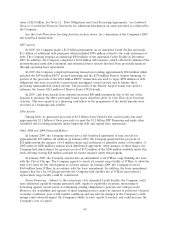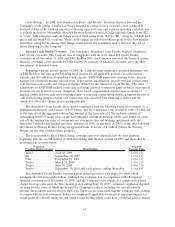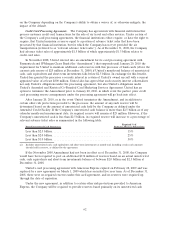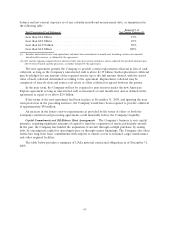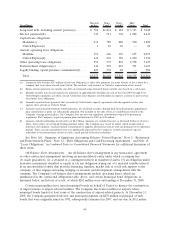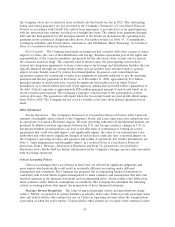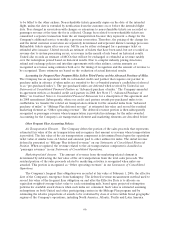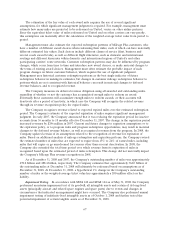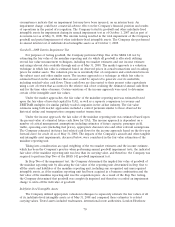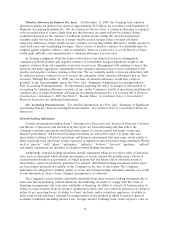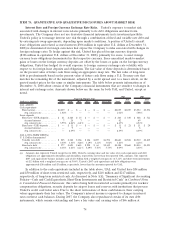United Airlines 2008 Annual Report Download - page 66
Download and view the complete annual report
Please find page 66 of the 2008 United Airlines annual report below. You can navigate through the pages in the report by either clicking on the pages listed below, or by using the keyword search tool below to find specific information within the annual report.to be billed to the other airlines. Non-refundable tickets generally expire on the date of the intended
flight, unless the date is extended by notification from the customer on or before the intended flight
date. Fees charged in association with changes or extensions to non-refundable tickets are recorded as
passenger revenue at the time the fee is collected. Change fees related to non-refundable tickets are
considered a separate transaction from the air transportation because they represent a charge for the
Company’s additional service to modify a previous reservation. Therefore, the pricing of the change fee
and the initial customer reservation are separately determined and represent distinct earnings processes.
Refundable tickets expire after one year. MCOs can be either exchanged for a passenger ticket or
refunded after issuance. United records an estimate of tickets that have been used, but not recorded as
revenue due to system processing errors, as revenue in the month of sale based on historical results.
United also records an estimate of MCOs that will not be exchanged or refunded as revenue ratably
over the redemption period based on historical results. Due to complex industry pricing structures,
refund and exchange policies and interline agreements with other airlines, certain amounts are
recognized as revenue using estimates both as to the timing of recognition and the amount of revenue to
be recognized. These estimates are based on the evaluation of actual historical results.
Accounting for Frequent Flyer Program Miles Sold to Third Parties and the Advanced Purchase of Miles.
The Company has an agreement with its co-branded credit card partner that requires our partner to
purchase miles in advance of when miles are awarded to the co-branded partner’s cardholders (referred
to as “pre-purchased miles”). The pre-purchased miles are deferred when received by United in our
Statements of Consolidated Financial Position as “Advanced purchase of miles.” The Company amended
its agreement with its co-branded credit card partner in 2008. See Note 17, “Advanced Purchase of
Miles,” in Combined Notes to Consolidated Financial Statements for a description of this agreement and
its 2008 amendment. Subsequently, when our credit card partner awards pre-purchased miles to its
cardholders, we transfer the related air transportation element for the awarded miles from “Advanced
purchase of miles” to “Mileage Plus deferred revenue” at estimated fair value and record the residual
marketing element as “Other operating revenue”. The deferred revenue portion is then subsequently
recognized as passenger revenue when transportation is provided in exchange for the miles awarded.
Accounting for the Company’s air transportation element and marketing elements are described below:
Other Frequent Flyer Accounting Policies.
Air Transportation Element. The Company defers the portion of the sales proceeds that represents
estimated fair value of the air transportation and recognizes that amount as revenue when transportation
is provided. The fair value of the air transportation component is determined based upon the equivalent
ticket value of similar fares on United and amounts paid to other airlines for miles. The initial revenue
deferral is presented as “Mileage Plus deferred revenue” on our Statements of Consolidated Financial
Position. When recognized, the revenue related to the air transportation component is classified as
“passenger revenues” in our Statements of Consolidated Operations.
Marketing-related element. The amount of revenue from the marketing-related element is
determined by subtracting the fair value of the air transportation from the total sales proceeds. The
residual portion of the sales proceeds related to marketing activities is recognized when miles are
awarded. This portion is recognized as “Other operating revenues” in our Statements of Consolidated
Operations.
The Company’s frequent flyer obligation was recorded at fair value at February 1, 2006, the effective
date of the Company’s emergence from bankruptcy. The deferred revenue measurement method used to
record fair value of the frequent flyer obligation on and after the Effective Date is to allocate an
equivalent weighted-average ticket value to each outstanding mile, based upon projected redemption
patterns for available award choices when such miles are consumed. Such value is estimated assuming
redemptions on both United and other participating carriers in the Mileage Plus program and by
estimating the relative proportions of awards to be redeemed by class of service within broad geographic
regions of the Company’s operations, including North America, Atlantic, Pacific and Latin America.
66


